Keyword research is an essential part of local SEO, as it allows you to target specific keywords and locations, helping your business to get discovered by searchers in your desired areas.
As local SEO keyword research is a time-consuming, and energy-draining process, most business owners disregard it, leaving their business with a huge gap between them and their competitors.
To make the local keyword research process easier for you, we have conducted a step-by-step process on how to research and target the correct local terms, that local visitors search every day.
What is Local SEO
Local SEO is the process of improving rankings for websites and offering products or services, for specific geographical locations.
The process of local SEO consists of targeting keywords that have local intent, increasing the visibility of a business for that specific location.
With that in mind, any business can optimize by performing a single or multiple-location SEO strategy, depending on how many branches a business has, or growth opportunities in different locations.
What are Local Keywords
Local keywords include specific locations and services, which are often searched by people who are looking for local products or services.
They are very different from globally searched keywords, as local keywords are ranked separately, and based on different ranking factors.
By targeting local keywords, a business removes global competition and competes against local outlets, that target the same location, and keywords.

While competitiveness depends on the city or state targeted, local SEO keywords can be quite hard to rank, depending on your competition, and target keywords.
How to Perform Local SEO Keyword Research
To perform a successful local keyword research strategy, we will be reviewing some simple steps, that can enhance the overall results, and find reasons to target local keywords.
The idea of this strategy is used by our in-house team and has been providing great results for newer websites, helping them to pass the Google sandbox stage, and rank for their first local terms.
List all products and services you offer
Before starting to implement local SEO strategies, or even choosing the main keywords for a local website, we have to determine if the business offers products or services and continue the path of spying on competitors, to find more profitable ideas.
When doing your own business, you would probably have all the ideas, and products or services listed in front of you.
However, are these local services or products being searched by customers?
The best way to understand this is by performing a simple Google search. Let’s say you want to start a remodeling company in Atlanta and wish to know the search intent behind this type of business.
Start by typing in the target city, and partially type the category of the business.
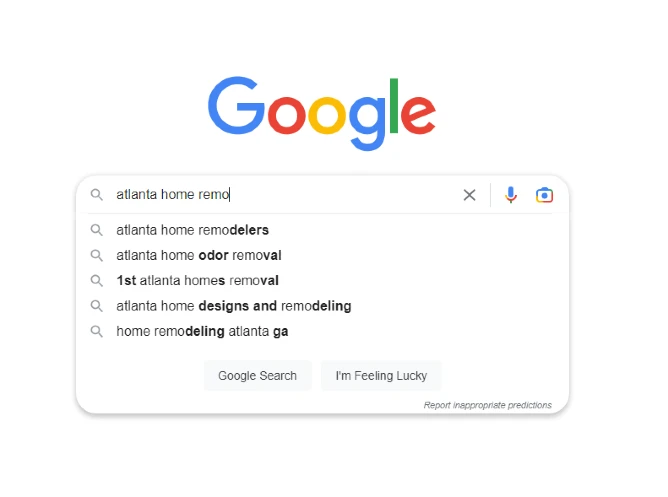
From the research done, now we can understand that searchers in Atlanta are looking for remodeling companies and odor removal companies.
In such a case we cannot combine both services but can find an odor removal company, and establish a partnership. This way we give quality services to local clients, and will lower their research times, by providing a full package of services, which can save time and money.
Now that we found a relevant local search term to serve as a heading for the homepage, we can easily repeat the process for all services or products a business can offer.
Use an SEO keyword tool
To further enhance our local SEO keyword research strategy, we will be using an SEO keyword tool, which can give us potential terms to include in our service pages and determine what’s the best fit for a local business.
Remember that each location has searchers who may use a different way to describe their issue, service, or products needed.
To gain the best results depending on the geographical location of a business, we will use a local SEO keyword tool, such as Ubersuggest.
The free version of Ubersuggest will give you 3 free keyword searches per day, and 2 more if you are logged into the tool.
Type in your location and keyword. For example, Atlanta remodeling. If you are a paid user, the option to filter certain geographical locations can be used to search the keyword “remodeling”, and the keyword research tool will show results based in Atlanta only.
Filter relevant to your business keywords
Now that we have the search term “Atlanta remodeling”, we can see hundreds of keyword opportunities that a business can rank for. However, each of those keywords may be irrelevant to the search, so we can easily narrow it to specific keywords.
By clicking the keyword filters we can exclude words contained in the suggestions, which will help us to find the perfect keywords to target on our business website.
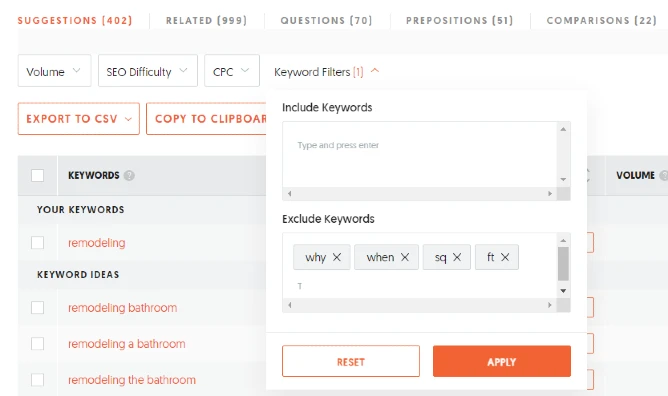
Since most of the irrelevant words in our target term are removed, we have a clear view of what the people in Atlanta search for when they require a certain service.
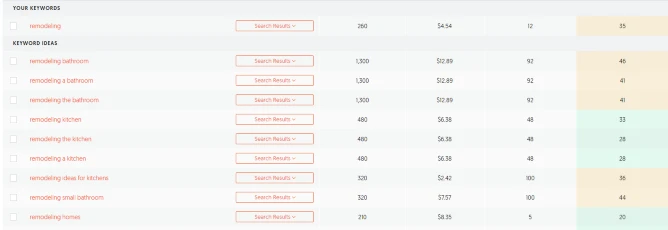
To improve our strategy, we can take a look at the suggestions tab, take all relevant to our query search terms, and apply them to our strategy.
After all, these are semantic keywords, which can be used to fill gaps in the content, enhancing the content, and rankability of the pages.
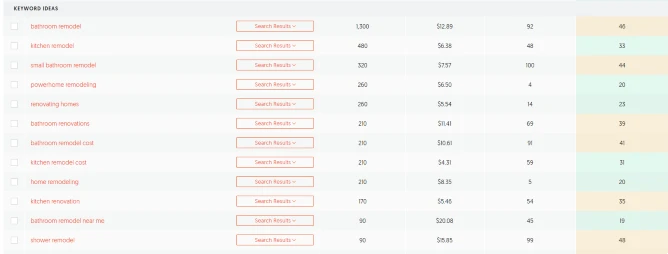
Short tail vs longtail local keywords
Creating our keyword list may seem complete, however, there is a simple thing that most business owners turn their back on. It’s the SEO difficulty or keyword difficulty.
Local SEO researching tools make calculations based on top-ranking sites. By combining their overall domain authority (DA), and presenting it as a difficulty level of ranking for the keyword.
With that in mind, most keywords, which consist of 1 or 2 words are harder to rank for websites with smaller content, or not enough domain authority.
To ease things up, many people take the route of using more keywords, to create a specific search query. These specific search queries consist of longtail keywords. They are very specific to the service or product a person is searching for, making them more powerful for conversions.
After all, the client knows what he is searching for, and provides special terms to receive that product or service, giving search engines an idea of what the intent of this searcher is.

Targeting longtail keywords can have smaller search volumes, but they are easier to rank for and bring more conversions. As mentioned before, clients who use longer phrases to find content, are usually looking to purchase a product, or service, or just need an answer to a very specific issue.
Including longer phrases in your content, can also rank your website for similar search terms, as Google ranks keywords based on relevancy.
With that said, you can rank for keywords similar to the ones you are targeting, without optimizing for them, because your targeted words, provide the same meaning, that a person is searching for.
Target local terms depending on your website performance (optional)
While this is not an important step, but optional for more competitive business niches, any of these strategies can give a boost to the overall rankings of the website, and provide hundreds of opportunities to outrank competitors.
1. Target keywords, which have the same or lower difficulty, than your website’s authority.
One of the main ranking signals is backlinks, and you will hear this from many SEO pros. The authority of your website presents how trustworthy your website is.
To increase the domain authority of your website, you will need to acquire backlinks from websites, relevant to your business category, or even site owners, who are close to it.
If you have a remodeling business but receive links from gardening sites, it doesn’t make those links pointless, but less relevant. The link juice from such a backlink is small, compared to a business with hundreds of links in the same business as you. It can be a blog, a local newspaper, or even a competitor.
To properly find keywords with lower difficulty scores, than your DA, you will need to filter keywords based on their difficulty.
For example, our website’s DA is 53, so we are going to target keywords below that score, making it easier to rank for those terms.
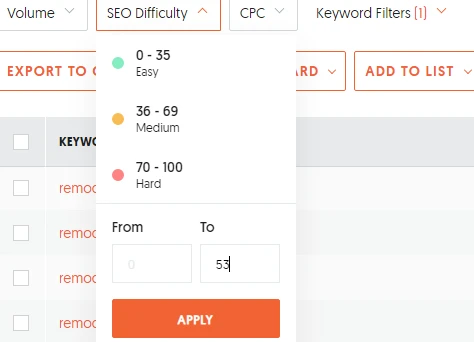
Now that we have narrowed our keywords to DA 53 or lower, we can easily target some longtail phrases, and make service pages based on them.

2. Target local search terms with the SEO avalanche strategy
The next powerful strategy that we have is called the SEO avalanche strategy. It’s a very fun, and easy-to-follow process, where you target keywords based on the traffic of your website.
All you need to do is compare your Google Search Console traffic with any keyword research tool.
If your website has 0 traffic, you should target only 0 traffic keywords, making it easier to rank, and helping you earn your first keyword rankings.
The traffic you will be earning from the lowest keywords is not actually 0. It’s just the estimates, that keyword research tools make.
In fact, these keywords can earn you anywhere from 0 to 10 traffic per month, rewarding your website with potential customers.
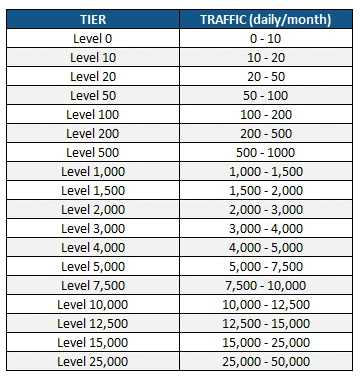
The idea of the avalanche SEO strategy consists of leveling your keywords. If you start earning 10 visitors per month, it means you have reached level 10 and can start targeting keywords with the exact number of 10 or fewer visitors.
Reaching more visitors will allow you to target keywords with higher volumes, building your local business authority, and consistent traffic.
To start with the SEO avalanche strategy, you will need to use a keyword research tool and use the lowest traffic keywords, counting from 0.

From the keyword list generated, these 2 keywords were a perfect fit for blog posts and gave a linking opportunity to the service pages.
3. Target keywords by applying the KGR strategy
KGR stands for keyword golden ratio, and it’s one of the best strategies to apply when starting a new product, or service website.
It’s a special strategy based on calculations, where no money is involved, and can be done without any SEO knowledge. Everything that’s needed for this strategy is a browser and a calculator.
The keyword golden ratio strategy requires a special search, which contains the “allintitle:” phrase written in the search box of a search engine. By using this term, we are telling search engines that the results should contain all keywords and no semantic words in the SERPs.
For finalizing the strategy we need to follow the number of “allintitle” pages and divide them by the search volume of the keyword
For this search, we used the keyword “remodeling a small basement”.
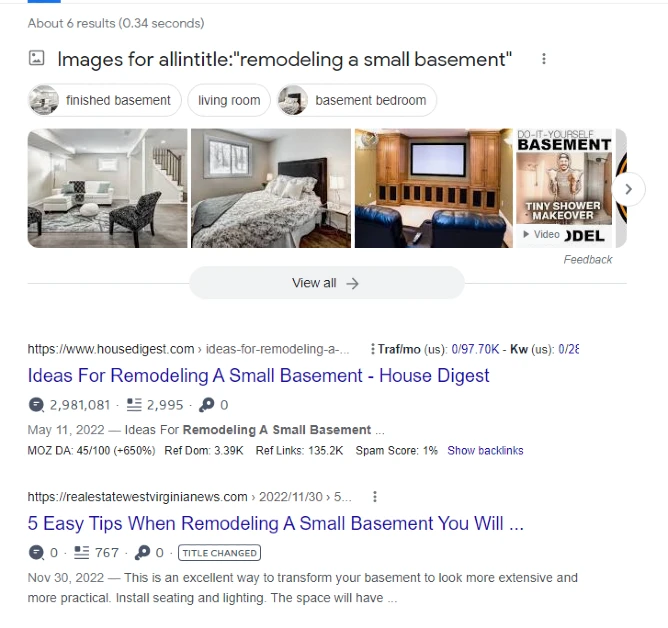
The number of pages found on the web was 6, and the total search volume for this word was 50. If we divide 6 by 50, the answer would be 0.12, making the strategy perfect. As it is a data-based strategy, we need to keep in mind the answer to the equation and look at the opportunities below.
If the result of the equation is 1 or above – It is not a KGR keyword, and will not provide us with quick ranking opportunities.
If the result of the equation is below 0.5 – The opportunity to rank is mid, and the target keyword should be ranking in the top 100 in a few days.
If the result of the equation is 0.25 or below – We have a perfect KGR term, and ranking in the top 10 can happen quite fast. The lower the result is, the faster a website can rank for this keyword.
Download the keyword lists
Now that we have chosen the perfect keywords based on our strategies, and have found a ranking opportunity, we can simply download all the lists, but not at once.
Make sure to mark the specific local keywords, and make a separate list based on the service you will be making a page for.
Having a separate list for each service can avoid confusion and have keywords grouped for the next steps, where we will teach you how to cluster locally searched keywords.
Input generated keyword lists in a content clustering tool
To create the perfect silo for your local business, you will need to use a clustering tool, such as Keyword Cupid, or any similar content clustering tools.
These tools are used to obtain the keywords from your lists and structure them so you can write your content based on their suggestions.
Content clustering tools will group all keywords, and create a list of articles, which can be linked together, improving the topical relevancy, and avoiding issues with your SEO strategy.
It’s a perfect way for beginners to understand how content should be interlinked.

Once you have a cluster for all of your keyword lists, you can start writing your first content pieces. Make sure to include all relevant grouped keywords inside your content, improving the visibility of the target local search terms, for better visibility of your target keyword.
Optimize your content with a local SEO tool
To write a good piece of content, the most important thing is structuring your content, and filling the gaps that your competitors have left.
Analyzing the web and competition for each keyword or heading can be time-consuming. That’s why a local SEO tool such as Surfer SEO can help you write the best content piece, by including mentioned keywords from competitors and filling the gaps they had left.

How to Track Local Keyword Rankings
Now that you have your service pages, and supporting blog posts published on your website, it is time to track your keyword positions and keep track of the competition.
The best way to track the competition is by following my simple method.
Keep your keyword lists for each service as they will be important while following through the 4 step process of tracking local keyword rankings.
1. Export keywords from Google Search Console
When a page gets indexed, it immediately gets placed somewhere in the SERPs. It is very important to follow what keywords a page is ranking.
To find information about indexed pages and keyword rankings, site owners can visit their Google Search Console, and gain a full understanding of their website’s performance.
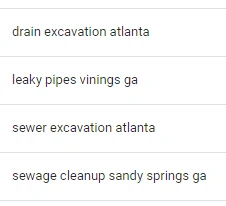
By going into the rankings tab, site owners can see the average ranking of a keyword per day, and easily export those keywords in a list.
To export keywords, we should be using the button “export” listed above the metrics provided by GSC.
After that, we can save the keywords list, and proceed to the next step.
2. Clear irrelevant keywords
Sometimes a business may get found for irrelevant search terms, which contain numbers, different tags, or even through using the “allintitle” option, as shown in the KGR strategy.
Such terms are not very good to track, as they do not weigh your strategy, and do not provide you with insightful information.
To start tracking keywords relevant to a business, all irrelevant search terms will need to be deleted, leaving the important ones only.
3. Place the keywords on a local keyword-tracking tool
Now that all relevant search terms are present, we can choose our keyword-tracking tool. In this case, you can use any kind of tool such as SERPRobot or similar position-tracking tools for local keywords.
Once you find the tool of your liking, make sure to create 2 different lists. In the first list, you can include all the keywords exported from Google Search Console.
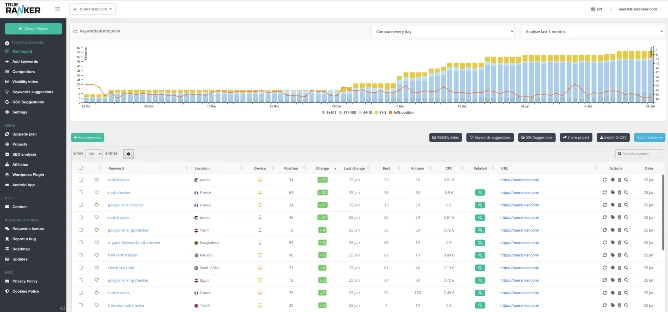
The second list will contain all keywords that were exported in the process of discovering potential local search terms.
This way a site owner will gain knowledge on how their main keywords are positioned in the SERPs, and which of these keywords were ranked by following the process.
4. Monitor local keyword rankings
When starting to follow the keywords you are ranking for, it is important to check the second list and its performance, because some of the terms acquired may not be positioned yet.
If some of the keywords are not ranked in the top positions, utilizing the KGR, SEO avalanche, or DA-based strategies can help improve their rankings.
After optimizing the underperforming keywords, you can leave them, as it will take some time for Google to re-crawl and reposition them, giving time to further optimize your website by applying local link-building strategies.
Conclusion
Creating keyword lists, and developing strategies is only a small part of the local search engine optimization process.
With such a tactic your website should be more powerful, however, more factors can boost your website’s rankings, including local citations, optimizing your Google Business Profile, and developing social media strategies.
While following our local SEO keyword research process does not guarantee instant results, it can help a small business grow.
